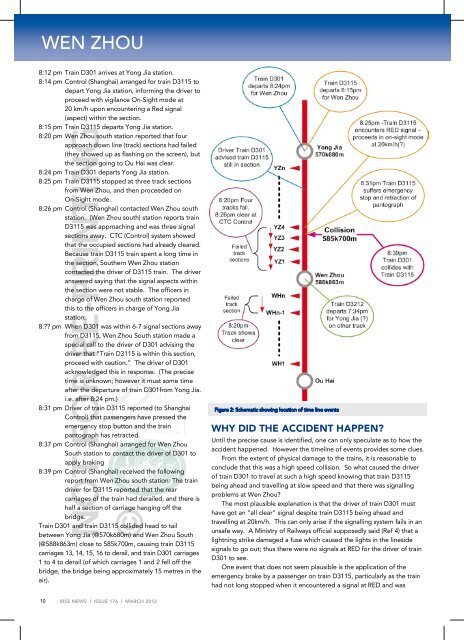IRSE News 176 Mar 12 with Watermark.pdf
IRSE News 176 Mar 12 with Watermark.pdf
IRSE News 176 Mar 12 with Watermark.pdf
Create successful ePaper yourself
Turn your PDF publications into a flip-book with our unique Google optimized e-Paper software.
WEN ZHOU<br />
8:<strong>12</strong> pm Train D301 arrives at Yong Jia station.<br />
8:14 pm Control (Shanghai) arranged for train D3115 to<br />
depart Yong Jia station, informing the driver to<br />
proceed <strong>with</strong> vigilance On-Sight mode at<br />
20 km/h upon encountering a Red signal<br />
(aspect) <strong>with</strong>in the section.<br />
8:15 pm Train D3115 departs Yong Jia station.<br />
8:20 pm Wen Zhou south station reported that four<br />
approach down line (track) sections had failed<br />
(they showed up as flashing on the screen), but<br />
the section going to Ou Hai was clear.<br />
8:24 pm Train D301 departs Yong Jia station.<br />
8:25 pm Train D3115 stopped at three track sections<br />
from Wen Zhou, and then proceeded on<br />
On-Sight mode.<br />
8:26 pm Control (Shanghai) contacted Wen Zhou south<br />
station. (Wen Zhou south) station reports train<br />
D3115 was approaching and was three signal<br />
sections away. CTC (Control) system showed<br />
that the occupied sections had already cleared.<br />
Because train D3115 train spent a long time in<br />
the section, Southern Wen Zhou station<br />
contacted the driver of D3115 train. The driver<br />
answered saying that the signal aspects <strong>with</strong>in<br />
the section were not stable. The officers in<br />
charge of Wen Zhou south station reported<br />
this to the officers in charge of Yong Jia<br />
station.<br />
8:?? pm When D301 was <strong>with</strong>in 6-7 signal sections away<br />
from D3115, Wen Zhou South station made a<br />
special call to the driver of D301 advising the<br />
driver that “Train D3115 is <strong>with</strong>in this section,<br />
proceed <strong>with</strong> caution.” The driver of D301<br />
acknowledged this in response. (The precise<br />
time is unknown; however it must some time<br />
after the departure of train D301from Yong Jia.<br />
i.e. after 8:24 pm.)<br />
8:31 pm Driver of train D3115 reported (to Shanghai<br />
Control) that passengers have pressed the<br />
emergency stop button and the train<br />
pantograph has retracted.<br />
8:37 pm Control (Shanghai) arranged for Wen Zhou<br />
South station to contact the driver of D301 to<br />
apply braking<br />
8:39 pm Control (Shanghai) received the following<br />
report from Wen Zhou south station: The train<br />
driver for D3115 reported that the rear<br />
carriages of the train had derailed, and there is<br />
half a section of carriage hanging off the<br />
bridge.<br />
Train D301 and train D3115 collided head to tail<br />
between Yong Jia (@570k680m) and Wen Zhou South<br />
(@588k863m) close to 585k700m, causing train D3115<br />
carriages 13, 14, 15, 16 to derail, and train D301 carriages<br />
1 to 4 to derail (of which carriages 1 and 2 fell off the<br />
bridge, the bridge being approximately 15 metres in the<br />
air).<br />
NOT FOR RE-PRINTING<br />
©<br />
Figure 2: Schematic showing location of time line events<br />
WHY DID THE ACCIDENT HAPPEN?<br />
Until the precise cause is identified, one can only speculate as to how the<br />
accident happened. However the timeline of events provides some clues.<br />
From the extent of physical damage to the trains, it is reasonable to<br />
conclude that this was a high speed collision. So what caused the driver<br />
of train D301 to travel at such a high speed knowing that train D3115<br />
being ahead and travelling at slow speed and that there was signalling<br />
problems at Wen Zhou?<br />
The most plausible explanation is that the driver of train D301 must<br />
have got an “all clear” signal despite train D3115 being ahead and<br />
travelling at 20km/h. This can only arise if the signalling system fails in an<br />
unsafe way. A Ministry of Railways official supposedly said (Ref 4) that a<br />
lightning strike damaged a fuse which caused the lights in the lineside<br />
signals to go out; thus there were no signals at RED for the driver of train<br />
D301 to see.<br />
One event that does not seem plausible is the application of the<br />
emergency brake by a passenger on train D3115, particularly as the train<br />
had not long stopped when it encountered a signal at RED and was<br />
10<br />
<strong>IRSE</strong> NEWS | ISSUE <strong>176</strong> | MARCH 20<strong>12</strong>
















